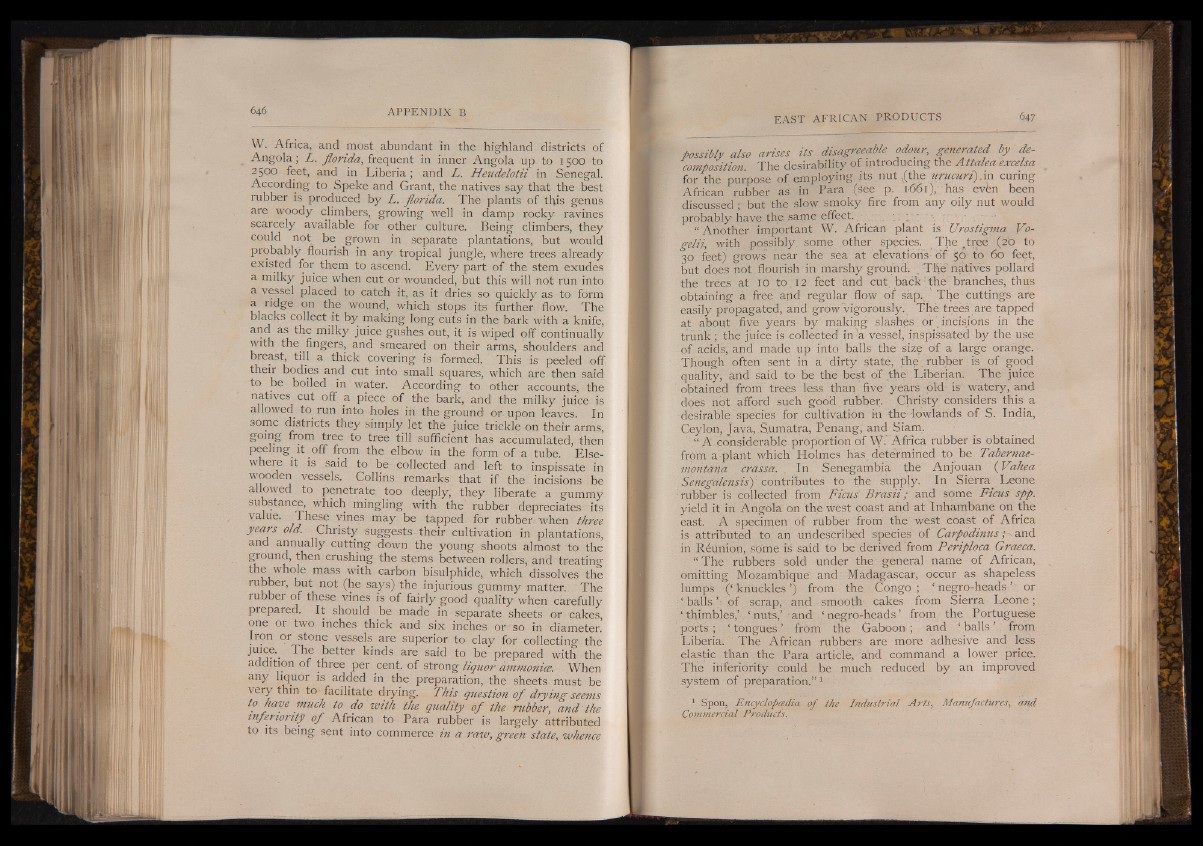
W. Africa, and most abundant in the highland districts of
Angola; L. florida, frequent in inner Angola up to 1500 to
2500 feet, and in Liberia; and L. Hendelotii in Senegal.
According to Speke and Grant, the natives say that the best
rubber is produced by L. florida. The plants of this genus
are woody climbers, growing well in damp rocky ravines
scarcely available for other culture. Being climbers, they
could not be grown in separate plantations, but would
probably flourish in any tropical jungle, where trees already
existed for them to ascend. Every part of the stem exudes
a milky juice when cut or wounded, but this will not run into
a vessel placed to catch it, as it dries so quickly as to form
a ridge on the wound, which stops its further flow. The
blacks collect it by making long cuts in the bark with a knife,
and as the milky juice gushes out, it is wiped off continually
with the fingers, and smeared on their arms, shoulders and
breast, till a thick covering is formed. This is peeled off
their bodies and cut into small squares, which are then said
to be boiled in water. According to other accounts, the
natives cut off a piece of the bark, and the milky juice is
allowed^ to run into holes in the ground or upon leaves. In
some districts they simply let the juice trickle on their arms,
going from tree to tree till sufficient has accumulated, then
peeling it off from the elbow in the form of a tube. Elsewhere
it is said to be collected and left to inspissate in
wooden vessels. Collins remarks that if the incisions be
allowed to penetrate too deeply, they liberate a gummy
substance, which mingling with the rubber depreciates' its
value. These vines may be tapped for rubber when three
years old. Christy suggests their cultivation in plantations,
and annually cutting down the young shoots almost to the
ground, then crushing the stems between rollers, and treating
the whole mass with carbon bisulphide, which dissolves the
ru^ er’ but not (he says) the injurious gummy matter. The
rubber of these vines is of fairly good quality when carefully
prepared. It should be made, in separate sheets or cakes,
one or two inches thick and six inches or so in diameter.
Iron or stone vessels are superior to clay for collecting the
The better kinds are said to be prepared with the
addition of three per cent, of strong liquor ammonia. When
any liquor is added in the preparation, the sheets must be
very thin to - facilitate drying, This question o f drying seems
to have much to do with the quality o f the rubber, and the
inferiority o f African to Para rubber is largely attributed
tp its being sent into commerce in a raw, greeti state, whence
possibly also arises its disagreeable odour, generated by decomposition.
The desirability of introducing the Attalea excelsa
for the purpose of employing, its nut 1(the urucurp),in curing
African rubber as' in Para (¿ee p. 1661), has evfen been
discussed § but the slow smoky fire from any oily nut would
probably have the same effect. - , - - • ■ • ■
“ Another important W. African plant is Urostigma Vo-
o-elii, with possibly, some other species. The „tree (20 to
30 feet) grows' near the sea at elpvatioris o f SO to 60 feet,
but does not flourish in marshy ground. T h e natives pollard
the trees at 10 to. 12 feet and cut. b a ck ’the branches, thus
obtaining a free and regular flow of sap.. The cuttings are
easily propagated, and grow vigorously. Thè trees are tapped
at about five years by making slashes or ’ incisions in the
trunk ; the juice is collected in a vessel, inspissated by the use
of acids, and made up into balls the size of a large orange.
Though often sent in a dirty state, the rubber is of good
quality, and said to be the best of the Liberian. The juice
obtained from trees less than five years old is watery, and
does not afford such good. rubber; Christy considers this a
desirable species for cultivation in the lowlands of S. India,
Ceylon, Java, .S.u.matra, Penang, and Siam,
“ A considerable proportion of WÏ Africa rubber is obtained
from a plant which Holmes has. determined to be Tabernae-
montana crassa. . In Senegambia the Anjouan ( Vahea
Senegalensis)' contributes to the supply. In Sierra Leone
rubber is collected from Ficus Brasii ; and some Ficus spp.
yield it in Angola on the west coast and at Inhambane on the
east. A specimen of rubber from the west coast of Africa
is attributed to an undescribed species of Carpodinus ; and
in Réunion, some is said to be derived from Periploca Graeca.
“ The rubbers sold under the general name of African,
omitting Mozambique' and Madagascar, occur as shapeless
lumps •'(‘ knuckles’) from the Congo ; ‘ negro-heads’ ; or
‘ balls ’ of scrap, and smooth cakes from Sierra Leone;
‘ thimbles,’, ‘ nuts,’ and ‘ negro-heads ’ from the Portuguese
ports; ‘ tongues’ from the Gaboon; and ‘ balls’, from
Liberia. The African rubbers are more adhesive and less
elastic than the. Para article, and command a lower price.
The inferiority could be much reduced by an improved
system of preparation,” 1
1 Spon, Encyclopoedia o f the Industrial Arts, Manufactures, and
Commercial Products.